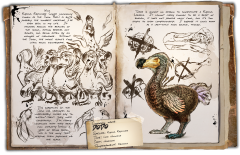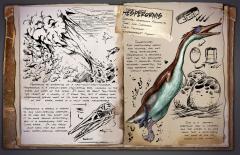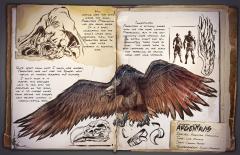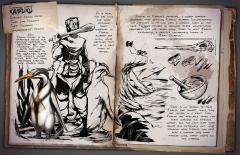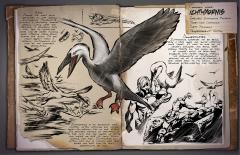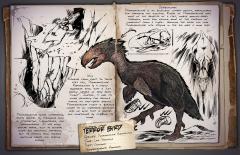Search the Community
Showing results for tags 'bird'.
-

Natunaornis gigoura Messenger pigeon!!!!!!
jimmibonanit posted a suggestion in Creature submission archive
Natunaornis gigoura What can't be missing in a city? PIGEONS!! I have traveled through many arks but when I came to earth I never imagined that there were still pigeons in the ancient city and that they still had the instincts of carrier pigeons and could even steal from other dinosaurs and people. Wild: These same ones, being wild, are the same as today's pigeons but larger and with a neutral temperament. They always make their nests on top of buildings but not too high in case a baby falls when trying to fly for the first time. Tame: Its domestication does not have much mystery, it is like modern pigeons, if you see a baby that fell from the nest you can claim it but it will not obey until you earn its trust by giving it the specific seeds it asks for, such as, for example, it can ask you berry seeds or X or Z seeds. domesticated: Once this one is tamed, you can put one of its two costumes on it: The thief suit is used so that with the hooks that the pigeon has, it flies towards a person or dinosaur and steals a random thing from their inventory, including armor pieces and mounts. The carrier pigeon suit is used to locate people or dinos from your tribe and send them to give them things that they carry in their backpack and put them directly in their inventory. You can also put coordinates on it like a delivery package and it flies to that position and leaves a backpack with what it had in inventory. end one vote equals a happy dove -
Wild: The Elephant Bird is a majestic sight to behold. Gentle and serene, these giants are solitary and ignore everything around them. However, they seem to become highly agitated and territorial around a member of the same species and gender. They also seem to show a particular aggression towards Terror Birds. If an Elephant Bird does become aggressive you have only a few seconds, as it raises its tail feathers in a display of aggression, to run as far as you can. Though large, its powerful legs help it move great distances very quickly, closing most gaps before you know what hit you. Domesticated: Its descent health, weight, and damage allow for a good all-around tame. The real strength comes with being able to run for long periods of time before needing to rest. With a multipurpose saddle that acts as a smithy and preserving bin with two seats, tribe members can be away from base for long periods of time. The trump card is a guttural trumpet call that causes all surrounding herbivores to be aggressive towards its target. This allows a fight to be either tipped in its favor or enough of a distraction to get out of dodge. Blurb: This is the all-terrain scout transport of Ark. Everything I’ve drafted is built around making it the best one possible. You’re not going to be fighting gigas with it, but it will easily take on anything its size or smaller. The Elephant bird is designed for travel and survival on the road, that’s the general concept. Spawn: Either Sunken Forest or Desert Taming: Elephant birds are omnivorous and while they mostly eat plants because of availability they love a good buggy meal. Bring any dead bug creature (arthro, scorpion, ant, araneo, etc) and it will gobble it up and become your best friend. The bigger the drag weight, the better the effectiveness. Also, make sure there are no other Elephant birds of the same gender or terror birds near by. Saddle: For travel and helping to make this creature really shine I think it needs a highly specialized saddle. My initial thought was smithy plus preserving bin. Could also make an argument for either swapping preserving bin for mortar and pestle or having all three. Abilities: High Stamina This creature can run at high speeds for long periods of time. While this may seem op, remember this isn’t a flier so it is restrained to the terrain and all creatures in its way. It can’t fly and land above all dangers. Well-rounded stats Again, you’re not meant to win any competitions with the stats that come out of this thing, but the idea is to be able to be adept at general survivability. Whether that’s having just enough speed and health to get away when confronted with a larger enemy or having just enough damage that anything smaller shouldn’t be too much of an issue. Tail Feather Flair This one is the lowest on my list of things. I thought of it because of the images of ostriches puffing themselves up for mating and intimidation. Was thinking could be a buff giver for speed. Again, the idea being either that you can attack quicker and therefore gain damage for smaller foes or have that little edge to quickly boots away for a few seconds from something bigger that would normally either match or outpace you. Trumpet Call The final trick up the survivability sleeve. You run around two rexes, or a rex and a spino, or two spinos, or a carcha or giga, or an enemy tribe. Now, you’ve got no choice but to give yourself enough space to run. So, you use the trumpet call and immediately all herbivores in the area begin attacking your target. Unless you get lucky and pull in a bunch of high-level trikes and stegos you’re not gonna get much firepower, but what you will get are meat shields. Now you puff your feathers, get that speed boost, and immediately turn and run the other way pouring one out for your new fallen brothers on your way. Closing thoughts: I wouldn’t take a fresh tame one on one with a wild 150 rex, but if you’ve got two, then your odds are good. And even if you can’t take your enemy, you’ve got all the tricks to make it so you never have to. Survivability and scouting are the names of the game.
-
- scout mount
- bird
-
(and 3 more)
Tagged with:
-

Introducing... DROMORNIS!!! The Prehistoric Lord of Blood Pacts
MRZOMBER posted a suggestion in Creature submission archive
(Vaguely based on Mohg, Lord of Blood from Elden Ring) Dossier Wild: You would think after all this time on the ARKs, I would eventually get used to the oversized and almost mythological inhabitants but no. Dromornis Nihallis as i have dubbed him, is not what i pictured for this flightless bird, but indeed much, much scarier. Dromornis stands at about the height of an Allosaur when stretched fully but usually stands a bit shorted due to it's posture. It's beak is jagged and almost malformed with an extra set of teeth inside the beak, most unusual for these birds. It's feathers are matted and mangey; This bird, by all accounts almost seems like a demon or monster and it's demeanor matches this observation. Dromornis is a fairly fast and vicious hunter employing its razor beak, knife-like claws, and its secret: The blood parasite. Dromornis has a parasite that appears to be the cause of its sadistic look. This parasite has formed a symbiotic bond with this bird, feeding off of Dromornis' kills while also giving it the power to hunt and kill enough for both of them. Tamed: I initially assumed after seeing many brutal fails at taming, that Dromornis was simply too savage. This appears to not be the case. An absolutely insane woman I met who only identified as "The Initiate'' claimed ownership of 3 of them. When I inquired on how she did this, she responded "I only accepted the blood bird for the gift that it was." Didn't ask more after that, but Dromornis has many interesting Attributes. For one, this bird's blood is normally extremely destructive to other creatures, but when exposed to the right ingredients it can make others much more powerful in a variety of ways. Only kicker is the parasite Will eventually die off, and if Dromornis wanders too far away from his blood pack, the parasite will drive the blood packmates into a frenzy until Dromornis returns, making them significantly weaker while it searches for its host. Dromornis itself, if excited enough, will sometimes projectile vomit its last parasite soaked meal at creatures as an attack but trust me, you don't really want to see this happen. It's not pretty Blood pack: Using Parasite blood, a "Pact Initiator" can be crafted. These Initiate creatures into the Dromornis' Blood pack. Dromornis can only have 3 packmates at one time. there are 4 variants: Damage Initiator: +30% DMG (50% DMG with "Blood Panic") (Only +10% for anything above 550 drag weight) Defence Initiator: +20% Resistance, +5 armor (40% RES, +10 armor with "Blood Panic") (Only +7.5% for anything above 55 drag weight) Torpor Initiator: Attacks now deal torpor equal to 2x damage done (4x with "Blood Panic") (Only 1.5x for anything above 550 drag weight) Blood Initiator: Grants "Blood Gift" Allows pack members to apply a bar on target that fills slowly based on damage done. when bar fills, 1% of health is instantly lost. (Health drained increased to 5% with "Blood Panic") (Only 0.5% health lost for anything above 550 drag weight) Dromornis requires 10% extra food on account of its parasite. Dromornis Gets a debuff called "Pack Wear" when gaining a pack member that gives Dromornis -7.5% DMG, RES, and +10% more food needed. Stacks with each Pack member for a total of -22.5% DMG, RES, and +30% more food needed. When 2 Dromornis Blood packs are nearby, all packmates of both Dromornis are enraged, attacking each other, regardless of tribe Affiliation. Dromornis' themselves are not affected by this, only the packmates If Dromornis leaves the area of its Packmates, Packmates enrage on anything nearby, also losing 15% resistance, until Dromornis returns. If Dromornis is killed while packmates are still alive, packmates get "Blood Panic" causing their Initiator to be massively boosted, while also draining 1% health per second. Drain can be alleviated by healing but can not be cured so it will eventually die. Dromornis can spawn wild with a blood pack. Wild Packmates will have a random initiator 50% chance of having not wild pack 25% chance of having 1 packmate 15% chance of having 2 packmates 10% chance of having 3 packmates Packmates can spawn as any of the following: Raptor Carno Rex Spino Therizino Bronto Terror Bird Dilo Chalico Araneo Stego Dromornis is close to a yuty in speed Base Stats H: 425 S: 600 O: 150 F: 2000 W: 350 M: 100% MS: 120% T: 2000 Abilities: Left Click : Serrated Bite Right Click : Power Kick C : Blood Vomit X : Screech Serrated Bite: Standard Bite that applies parasite debuff lowering targets damage by 5% and resistance by 5% and constantly drain health at a very slow pace (scales with melee). This buff can stack, but only up to 4 times and only if different Dromornis apply it. 1 Dromornis can only apply the debuff once. Upon biting a target, generates 1-2 "Parasite Blood" in inventory. Power Kick: High damage charge attack. More it is charged, the more damage it does. Applies "Blood Kicked" which builds up a bar on the target. once this bar reaches 100%, 3% of targets health is instantly lost. Charge is based on damage done by Dromornis Blood Vomit: Can only be done if in a full blood pack. When all 3 blood pack members are present a meter will appear for Dromornis. This meter will fill very slowly based on kills by the pack. it does not deteriorate. Damage and amount of blood vomit is based on how many kills Domornis gets then eats. Has to land finishing blow on target and eat the body to apply. Can, at maximum, vomit 5 pools of blood with full charge. Blood pools will linger anywhere between 3-10 seconds on the ground and will apply the parasite debuff and deal constant damage to anything that steps on the pools. Dromornis and its' blood pack are immune to the pools. Friendly creatures not affiliated with Dromornis are not immune and will take damage. Screech: Dromornis will screech and scream wildly causing blood pack members to frenzy, gaining 15% movement speed and Immunity from bleed for 1 minute. Taming: Dromornis requires a new host for it's parasite: you. Killing wild Dromornis will drop 1-3 "Bloody feathers" 15 of these feathers and 20 leech blood with get you a "Dromie Effigy" When approached with this effigy, Dromornis will curiously approach you and vomit a bloody lump. You must consume the bloody lump. Upon consumption, Dromornis will do a happy animation and watch you, following you around slowly and cautiously. You gain "Blood Sickness" sickness drains health constantly , causes aberration hallucination effects, inverts controls, increases wild creature aggression, Causes you to vomit blood, can take control of you like a noglin aggroing onto everything not Dromornis in the vicinity, and leaving you with 50% reduced movement speed and unable to ride dinos until Dromornis is tamed or you die. higher level Dromornis will build taming affinity slower than a lower level. Higher levels will also cause "Blood Sickness" effects to happen more often. Effects are entirely random, except the movement speed debuff and health drain, and, when survived, give an affinity boon. Boons are as follows Blood Vomit: +0.1% Control Invert: +0.2% Hallucination: +0.3% Aggression Increase: +0.4% Mind Control: +0.5% Affinity boons from sickness effects can be multiplied by up to 3x depending on level, lower levels giving more affinity Saddle: level 79 Initiator base cost: 50 Crystal, 50 leech blood, 100 Dromornis parasite blood. Specific costs: DMG Initiator: 10 rex arms, 5 Tuso tentacles, 25 Black pearls RES Initiator: 5 Sauropod vertebrae, 10 basilo blubber, 50 Polymer (organic) Torpor Initiator: 25 Titanoboa Venom, 15 Megalania Venom, 150 Bio Toxin Blood Initiator: 200 Blood packs, 35 Leech blood, 400 Silica pearls Strengths and weaknesses Strengths: Dromornis is a hybrid of a damage dealer/support creature. Using the blood pack ability can allow you to fill certain niches in your army. for example; boss fights. Giving blood or damage initiators to 3 allos would make for quick work of a boss. or maybe you need to tame? give a something lightweight a torpor initiator to help with knockouts. Dromornis is great for area control and denial. Using screech will allow your pack to take threats head on with the added speed to keep up. Between Blood Vomit, Screech, and your pack, Dromornis can completely control an area to your liking. Alternatively, Dromornis is a very capable damage dealer. Without a Blood pack, Dromornis can be deployed en mass to maximize the effects of the Parasite debuff. Sufficiently breed Dromornis groups would be able to completely cripple and bleed out even the strongest of enemies. Since DOT effects are based on melee damage, the bleed effect could become very powerful Weaknesses: Dromornis' Blood pack, while powerful, cripples it. It is very much a glass cannon type of creature and with the debuffs from its pack, it will be very weak. Simply ignoring its pack and singling it out will cause the pack to eventually die out, if you can manage that. they also have another weakness: Certain mammals have out grown the parasites effects and are immune to it, while also doing 10% more damage to Dromornis itself. These creatures are immune to the parasite debuff, disregard pack initiators, and also can not be initiated into a Dromornis Blood pack. These creatures are: Mammoth Direwolf Sabertooth Equus Desmodus Onyc Megatherium Using any of these will make quick work of any Dromornis and its pack. As previously mentioned, it is very weak in terms of health. If you have and equally strong damage dealer with more health, it will decimate groups of Dromornis. Dromornis is a tall Terror Bird Relative that is slightly shorter than an allo. it is covered in mangey grey and black feathers with a red orange and yellow plume on the head and neck. It has long stocky legs and Sharp claws. Its beak is jagged, serrated, Sharp and almost malformed with a long and slender eye. its tail is peacock-lick without the ability to flash the tail. (WIP Sketch. Not final art) Art by Lapis Lazuli (Very cool guy) Feel free to add on your ideas and suggestions to Dromornis! This is my first concept I've done and I'm very proud of how it turned out, but I'd be happy to hear anyone else suggestions. -

Aurornis Xui (Gliding,BattleMount)
BloodFoxxAngelica posted a suggestion in Creature submission archive
My Goal Is To Educate People About Aurornis, First let me tell you About Aurornis Xui In Real Life, Aurornis was roughly the size of a modern pheasant, with a length of 50 cm (20 inches). It had clawed wings and a long bony tail. Its leg bones were similar to those of Archaeopteryx, but overall its anatomy was more Primitive Aurornis lived roughly 160 million years ago, roughly 10 million years before Archaeopteryx, which often has been described as the first bird. Wild : Aurornis Xui, Although Seems Cute and Cuddly From Afar,Do not approach It As Its Powerful Beak and Talons Can Shred Even the Toughest Of Creatures! Males Have A Luminescent Tail and Head Feathers,while males have Extra Feathers under its beak. The Females Have A More dull Look While a Shorter Tail And No Head Feathers. Aurornis Are Often Seen Hunting in a Pack of 3, 2 Females and 1 Male, Rarely Even all 3 Of same Gender Or 2 Males and 1 Female. Some Packs Have Been Witnessed To Raise Other Baby Dinos In There nest With there Own Young. Killing A pack Of Aurornis Xui Will benefit you Greatly as it Will drop Feathers Another More Softer and Prettier Alternative To Make Beds and sleeping bags (Beds and Sleeping Bags Crafted from Feathers Have A shorter Respawn Timer and The Beds and sleeping bags crafted from Feathers wil have A Feather Look instead of Typical Hide look), Alternatively Can make a Aurornis GlideSuit, A More Faster and Cooler GlideSuit. Domesticated : Aurornis Xui, While Domesticated Can Benefit you Greatly, It can Jump High While Aurornis Cannot Fly it can Glide While Gliding it Opens Its Tail and Wings Wide and Can Glide Up to Hours Until It Touches the Ground,While Being a Semi-Flying Dinosaur it can Swim Very Well, While Getting Scent of Insects Aurornis will Become Raged and Go on a Killing Spree on Insects Dealing 25% More Damage To Creatures. Aurornis Can be Paired and This Creature While Being A Little Bigger Then an Iguanadon Can Kill Even The Supposed King Of Dinosaurs Tyrannosaurus Rex, With its Talons and Cause Bleeding and Can even Latch On to Creatures Bigger then a Allosaurs and up, While Pouncing Smaller Dinos Down to a Raptor, Smaller then a Raptor It Can grab with Its beak and Few to none can escape Its Grasp. it Can Also Somehow Latch onto Flying Dinosaurs (More specifically Like the Quetzal) i Saw Tribes using this to Try To Bring Down Quetzals, Even Other Tribes Used Aurornis to "Injure Flying Dinosaurs" Making them Forcefully Land or drop to the ground, For Trapping or Easily Killing them. You can Make The Aurornis Make a Nest Big Enough to Hatch The Biggest of Creatures, Enable There Mother Instinct On Female Aurornis And it will Sit on the Eggs until 5% ( Almost Ready To Hatch), It will Keep Screeching Until The baby is Hatched, The Aurornis mother will AutoClaim and If You give her The necessary Things she will Imprint and Also Raise The baby up! Extra Notes : 1. it Can Latch onto Giant Dinosaurs (More specifically Like the Quetzal) Imagine your trying To tame a Quetzal, But only Low lvls Are on map, There are Few Low to mid Tier Dinos that Can Catch up to a quetzal Therefor making it more Useful. 2. The Idea is It can "Injure Flying Dinosaurs" Making them Forcefully Land or drop to the ground, For Taming or Easily Killing them , This DeBuff Could last up to 1min (Similar to the Net from Gen 2). Vote For Aurornis For a New Boss Fighting and Terrain Crossing Birdy Friend, 🐦 (Sorry My female Aurornis Sketch Wont upload, but it was shown as Dossier Says ) -

Harpagornis Moorei - the stupendous slayer of the skies!
SirGlobbyLot posted a suggestion in Creature submission archive
Image at the bottom! Dang Forums making it hard to see... Dossier: “It always surprises me when I find extinct animals on the Ark that are so much larger than they should be! Such is the case with the Harpagornis Moorei, now a winged omen of death! Almost permanently flying as high as the Ark reaches, it never descends below a certain altitude and hunts anything that flies up to meet it. Get too close and the Haast Eagle, as it’s informally known, shreds its prey with those enormous talons! Anything unlucky enough to be caught will quickly bleed out, and trying to outfly that winged terror when slowed is a recipe for a grisly end. Taming the Haast Eagle takes aerial supremacy for any tribe; it must be knocked out high in the air, and a keen-eyed Survivor can look out for their nests atop mountains to signify an Eagle is high above! Tamed Harpagornis are incredible battle-mounts, capable of lifting creatures bigger than itself and tearing them apart. I’ve seen a tamed Eagle build two nests across the Ark, flying between them by command without a rider! These could be useful for long-distance transport, and their nests are so cosy that they act as a primitive incubator for eggs!” Art by the brilliant @timinybillybob - look him up on the webz! Description: So, you’re off flying round the Ark. It’s a lovely sunny day, you’re high above those Gigas, and the shield dome shimmers above. But wait, what’s that ahead? You’ve flown too high, flown too close. The Haast Eagle has spotted you, and you’re going to have to get out of there! Alright, so look, I know the Latin name was changed, but Harpagornis just sounds better. I love flying round on Ark, as it’s easily the easiest way of getting around. Aberration even blocks fliers to make it harder. But still, jump on a Pteranodon, a Quetz, fly up and the only threat is running out of stamina. Maybe a Wyvern or Argy if you nip to the loo and forget to land somewhere safe, but still, the airspace of the Ark is too comfortable. No longer! The Harpagornis was the largest recorded Eagle of all time, and was a fearsome hunter capable of taking down Giant Moa, performing strong attacks to knock its prey down. They were also similar to vultures, slurping out insides from corpses they would find. “But it sounds like an Argy!” I hear you say. Yep, it’s a big bird boi! The Harpagornis will be, literally, the sky-Giga. The deep ocean has Mosa and Squid which won’t follow you upwards, the ground has Gigas and Carchas which won’t follow you toooo far, and the sky will have the Haast Eagle, which won’t follow you down. There would only be one or two spawning at a time, similar to a Giga, due to their incredible health, damage potential, and stamina. The Eagle permanently resides in the highest parts of the Ark’s airspace, far beyond sight of those on the ground. Wild Eagles hover about the Ark as if it has unlimited stamina, and is obviously an aggressive creature. Similar to the Mosasaur underwater, the Eagle is the most fearsome creature up high, yet it prefers not to fly too close to the ground. If an unwitting flier approaches too close, all it needs to do to escape is head down! If not, the Roc swoops in on giant wings, and those talons can cause some significant bleeding! As you know, bleeding fliers are practically useless, so you’ll really want to dodge that attack! To tame an Eagle, tribes will need to employ their best flying creatures and load up on ammunition, as the Harpagornis will need knocking out whilst it flies, similar to a Quetz. If it wakes on the ground, it will immediately fly upward until it reaches the safety of the sky. Clever survivors will build traps to prevent the Eagle from escaping! Tamed birds are fearsome battle mounts, as nothing rivals them in the air. They can even prey on the largest land mounts such as Giganotosaurus or Titanosaur by slashing with their talons and waiting above for their poor prey to bleed out. Tamed Eagles will, of course, land on the ground when commanded, and they can create their own nest which serves as a natural egg incubator for other eggs; this will be a temporary structure which can be damaged, so be careful where you place it. The nest will have 3 spaces for eggs, and will keep them perfectly incubated unless the nest is destroyed. Tamed Eagles can create two nests, and when roosting at one, they can be told to fly to the other nest without a rider, allowing them to transport items, dinosaurs, and even people with no rider! This is designed to be a higher-end alternative to teleportation without using tek, as I know ASA will be able to implement the tracking required. The Eagle would fly directly up to a set height, fly across, then descend straight down. Be careful using this feature on PVP! As discussed, they’ll have a normal attack and a special talon attack similar to an Allo chomp which inflicts a chunky bleed effect. Eagles will be able to pick up creatures up to Rex size (no bigger!) and can attack whilst holding a creature. Their speed would likely be around Quetz flight speed or up to Giga run speed at full sprint, as a super-strong, super-fast bird is likely to be hell unless you have turrets galore. This will be the ultimate king of the sky, a true terror of the clouds. Please consider voting for my big birdy boi! I’d love to hear any feedback as, together, we can all get the Haast Eagle into Ark! If you have any ability ideas, feel free to post and fingers crossed Wildcard can choose the best of all of our ideas! Hey look, you made it to the end! You’re a good egg.- 17 replies
-
From the album: Dossiers
Common Name: Dodo Species: Raphus replicare Time: Late Holocene Diet: Herbivore Temperament: Oblivious Wild: Raphus replicare (more commonly known as the Dodo Bird) is quite possibly the dumbest creature I've ever seen in my life. It wanders around the beaches of the island, eating berries off bushes and being eaten by all manner of carnivore. Without the Dodo the whole Island's food chain would disintegrate. This subspecies of the Dodo has developed an unbelievably clever way to sustain itself: they mate constantly. I'm fairly convinced that they reach full maturity within a week of being born. This is the only trait keeping them populous on the island. Domesticated: There is almost no reason to domesticate a Raphus replicare. It cannot carry enough to be a beast of burden, it does not provide much food, and it's too stupid to show companionship. I suppose it could work as a last-ditch food source, though. -
From the album: Dossiers
Common Name: Hesperornis Species: Hesperornis Avenatantes Time: Late Cretaceous Diet: Piscivore Temperament: Flippant Wild: Appearing as something of a half-duck-half-dinosaur, Hesperornis is a medium-sized fish-eating bird, common in the rivers and lakes os the island. It would be about two-thirds the height of a human, if it stood tall, but it rarely does. Hesperornis spends most of its time gliding along the surface of the water, where it is much more maneuverable. Hesperornis is barely a threat to any land-dwelling creature, as its legs are too short for it to move around effectively, but it is a surprisingly fast on the water. It can easily hunt down fish and other small water-dwelling creatures. Domesticated: Not particularly useful for hunting, and not being affectionate, Hesperornis is primarily kept for the specialized eggs it produces. When rendered correctly, the eggs separate into two distinct substances: One is a protein substance high in calories, and the other is an oily liquid that is effectively the same as the oil found in the ocean!- 1 comment
-
- hesperornis
- flippant
-
(and 6 more)
Tagged with:
-
From the album: Dossiers
Common Name: Argentavis Species: Argentavis atrocollum Time: Late Miocene Diet: Carrion-Feeder Temperament: Short-Tempered Wild: Lording over the skies across the island, Argentavis atrocollum has few aerial rivals. It is a small consolation for the island's other avian Creatures, then, that Argentavis seems to have little interest in anything alive. Although they are not interested in many animals, Argentavis will attack any human within sight making them an aerial threat to many humans with basic equipment. Quite apart from what I would have guessed, Argentavis does not have the stooped neck typical of modern buzzards and vultures. It is unknown if it adapted this stronger neck to deal with predators on the island, or if its lineage comes from before the stooped neck became common in carrion-eating birds. Domesticated: Argentavis is actually slower than the far more common Pteranodon, but it has significantly more Stamina, and can sustain flight for approximately three times as long. This makes them the best Creatures on the island for traveling or hauling cargo over long distances.-
- argentavis
- argent
- (and 8 more)
-
From the album: Dossiers
Common Name: Kairuku Species: Kairuku waitaki Time: Late Paleogene Diet: Piscivore Temperament: Friendly Wild: Kairuku Waitaki is an amazingly docile and friendly creature, to everything but fish. Honestly, I'm not quite sure how Kairuku manages to stay populated across the islands colder climates, with the many predators stalking these frozen lands. It is weak, and only one small defensive trait: suspended in Kairuku blubber are small, dense particles that act as a light form of armor. Adding to Kairuku's problems, a clever survivor discovered that refining Kairuku blubber (concentrating the particles in it) can yield a natural form of the same Polymer utilized in advanced tribes' manufacturing processes. This has caused many tribes to hunt Kairuku extensively, a practice colloquially known as "Kairu Clubbing". Domesticated: There is no reason to tame Kairuku for combat since they are useless in a fight. Still, Kairuku are regularly tamed for their cuteness and friendly nature, and the fact that their bodies run extremely hot. Just standing near Kairuku can help keep a survivor stay warm through long, harsh nights on the icebergs.-
- penguin clubbing
- organic polymer
- (and 10 more)
-
From the album: Dossiers
Common Name: Ichthyornis Species: Ichthyornis piscoquus Time: Late Cretaceous Diet: Piscivore Temperament: Skittish Wild: Among the most vocal creatures on the island, Ichthyornis Piscoquus is actually a relatively normal seagull. Living near the beaches, it primarily eats fish, and its distinctive cries can be heard echoing over literally every beach across the island. As you might expect from a seagull, Ichthyornis will flee at the slightest provocation. Ichthyornis is an excellent fish hunter, often catching and killing small-to-medium fish in one attack. Its primary method of predation is to dive into the top layers of water and impale or bite its prey. When looking for fish,Ichthyornis will often just fly in circles over the water and wait for its next opportunity to dine. Domesticated: Ichthyornis surprised me by being a very loyal and social creature, once tamed. It likes to ride on its owner's shoulder, and bring that person treats (in the form of fish, of course) which its beak-grip enhances with extra healing vitamins. The personality of Ichthyornis reminds me of a housecat hauling a dead lizard back to its family, except bringing extra-healthy fish instead.-
- ichthyornis
- bird
- (and 7 more)
-
From the album: Dossiers
Common Name: Terror Bird Species: Phorusrhacidae Rapidesultor Time: Late Paleocene Diet: Carnivore Temperament: Aggressive Wild: Ranging from eight to twelve feet tall, Phorusrhacidae Rapidesultor is a highly aggressive avian that is just barely capable of very brief "flight" . Instead, it uses its wings primarily for balance during its high-speed sprints. Phorusrhacidae flight is actually closer so an impressive sustained leap or glide that is assisted and lengthened by flapping its wings. Phorusrhacidae shows interesting traits related to theropods such as Utahraptor, Carnotaurus and Tyrannosaurus. It has many similar traits such as general shape and predation patterns, but its attacks tend towards lightening dashes and leaping slashes. Domesticated: Phorusrhacidae is an excellent combat mount, particularly for harassing and scouting. Riders of Phorusrhacidae gain most of the benefits of a fast, mobile ground-based theropod, while also gaining some of the freedom of movement from a flyer... Assuming the rider can coax Phorusrhacidae into staying in the air over a long leap.
